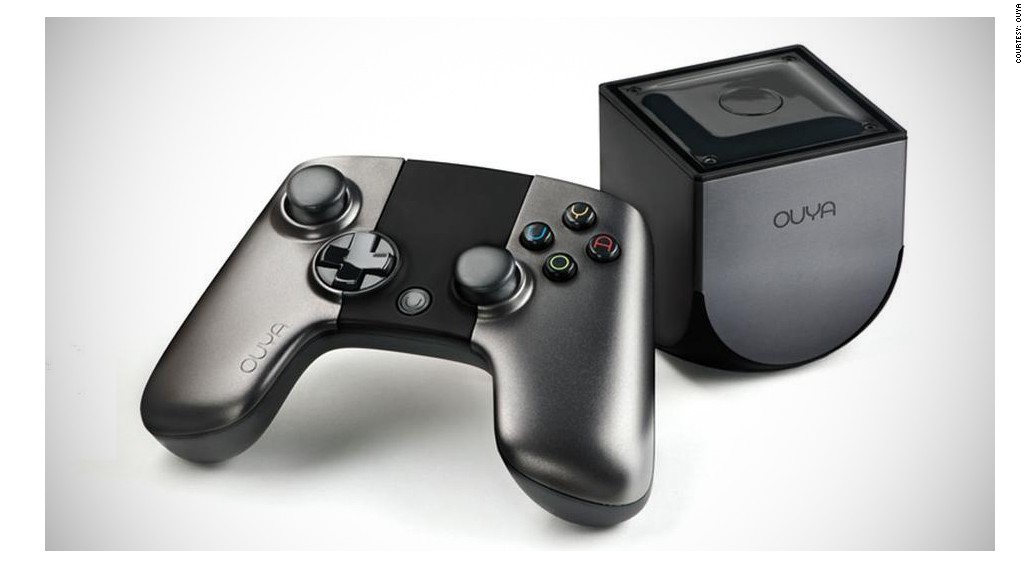
After years spent lurking in the shadows, the indie gaming world is ready for its moment in the spotlight. When the Ouya "micro-console" hits shelves on June 25, it could make big waves in the industry.
At this year's Electronic Entertainment Expo in Los Angeles, we learned that Sony's (SNE) upcoming PlayStation 4 and Microsoft's (MSFT) Xbox One consoles will cost $400 and $500, respectively. The Xbox One will still require a subscription fee for online gaming, and games will likely cost $40-$60 apiece.
The Ouya, however, will only cost $100. Every game will have a free-to-play demo of some sort.
Aside from the cost of the games themselves, which will likely be in the $5-$15 range, the only other costs will be for in-game purchases.
Though designed for the living room, the Ouya is built on the same guts as a smartphone, and runs a heavily-modified version of Google's (GOOG) Android. Ouya is focusing on the game playing experience over graphics.
But why now?
Related: Ouya could change everything in gaming
Mainstream PC and console gaming is now a $78 billion dollar industry which markets itself around games that push the limits of graphics. As a result, developers who want to scale back on graphics are often forced to develop for more obscure platforms.
In recent years, indie developers have been aided in part by the rise of Apple's (AAPL) iOS App Store and Valve's Steam PC store, which offered (mostly) unfettered access to millions of people, many of whom did not fit the mold of the traditional gamer.
But those companies have been focused on their mobile and PC platforms, which has left the living room wide open. The argument behind Ouya is that there's an untapped, unique experience for indie gaming on the big screen.
The Ouya seems perfectly catered to a person who likes gaming, but is not willing to spend the time and money required for big console games.
The thing is: Are there enough of those casual gamers to make the Ouya a success?
It's definitely a huge question. But Ouya CEO Julie Uhrman says she isn't ignoring hard-core gamers. She wants to attract the same people who will buy the PS4 and Xbox One. To accomplish this, the company is working with some of the top independent software developers on exclusive games for Ouya, in the hopes that it becomes a must-have device.
"We don't want to just throw a bunch of mobile ports on the box and call it day," said Uhrman.
But that $100 price tag and retail partnerships with Target (TGT) and Best Buy (BBY) are a sign that Ouya is just as interested in reaching a more mainstream demographic as well.
Related: Free is the hottest trend in games

Some, including Super Meat Boy developer Edward McMillen, are skeptical of the overall potential of micro-consoles, arguing that the clientele simply isn't there.
"People who don't already have a PlayStation or Xbox aren't going to go looking for another gaming device to put in their living room," said McMillen. "That's the reason why they play games on their phone to begin with: it doesn't look like a gaming device."
Others are a bit more optimistic about Ouya's future. Developers such as Shawn McGrath, who produced the visually stunning Dyad for PS3, and Rami Ismail, part of the Vlambeer duo who created the wonderfully strange iPhone game Ridiculous Fishing, are both intrigued by the potential of the platform.
Both have been working on games for the Ouya, and believe the device has plenty of processing power to create the same satisfying experiences you'd get on any other device.
But what excites these developers most is that Ouya has built itself around the spirit of indie gaming.
"I like the fact that its open and relatively inexpensive," said McGrath. "And the fact that they care is exciting."
There's still some work to be done on the hardware though, which is a little rough around the edges. Depending on the game, the feel of controls can range from responsive to laggy. Some 3D titles with visual flair are prone to stuttering and slowness.
But Ouya is less than a year old, and the company says it's committed to constantly improving the platform. Since the launch of its developer version, Ouya says it has rolled out several software and hardware improvements that made its way into the consumer version of Ouya.
Related: Can Microsfot's Kinect finally deliver for gamers?
The biggest thing Ouya has in its favor is a willingness to experiment with new ideas and the flexibility to do so. It will almost certainly cause the company to stumble along the way, but could also allow them to happen upon video game gold.
Developers already see the potential in having an open sandbox for outlandish ideas. And with other exciting gaming technologies on the rise, such as the Oculus Rift VR headset, the possibilities for collaboration are endless.
With Microsoft continuing to keep indie developers at arm's length, Sony primarily focused on big-budget games, and Nintendo still figuring things out, the time seems to right for an indie-centric gaming box to come along.
Ouya has the best chance to succeed. Now it just has to convince the rest of the world.

